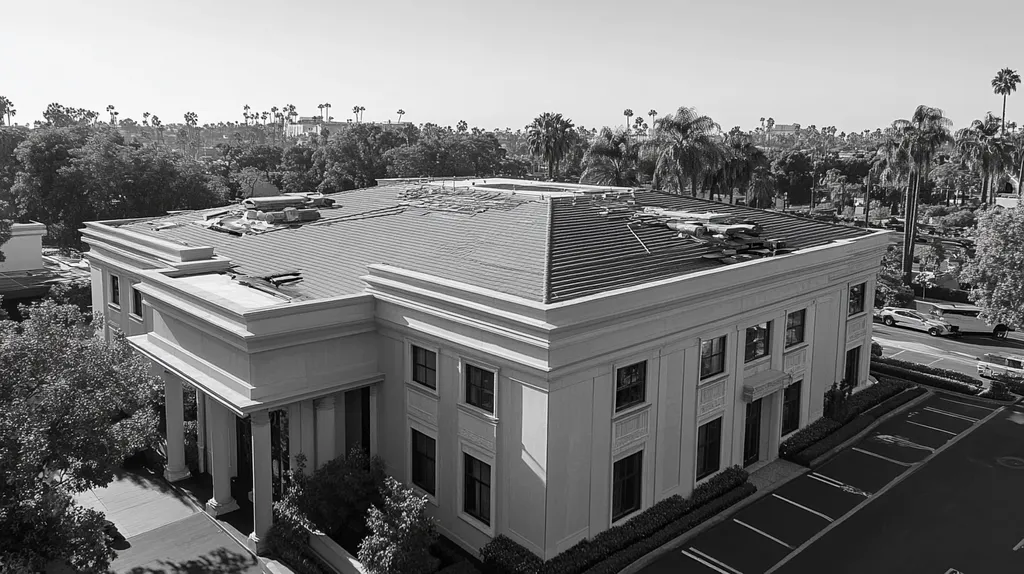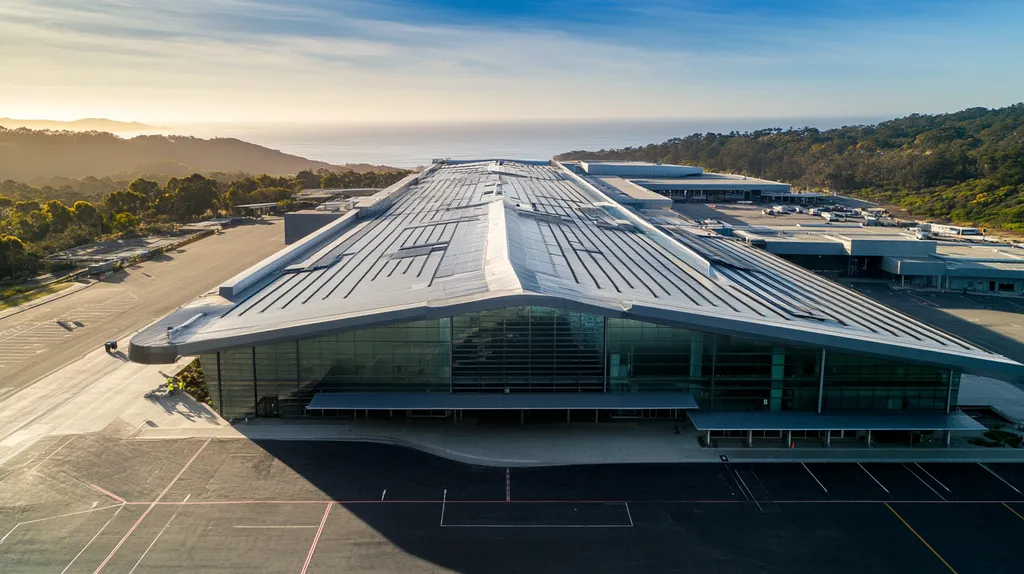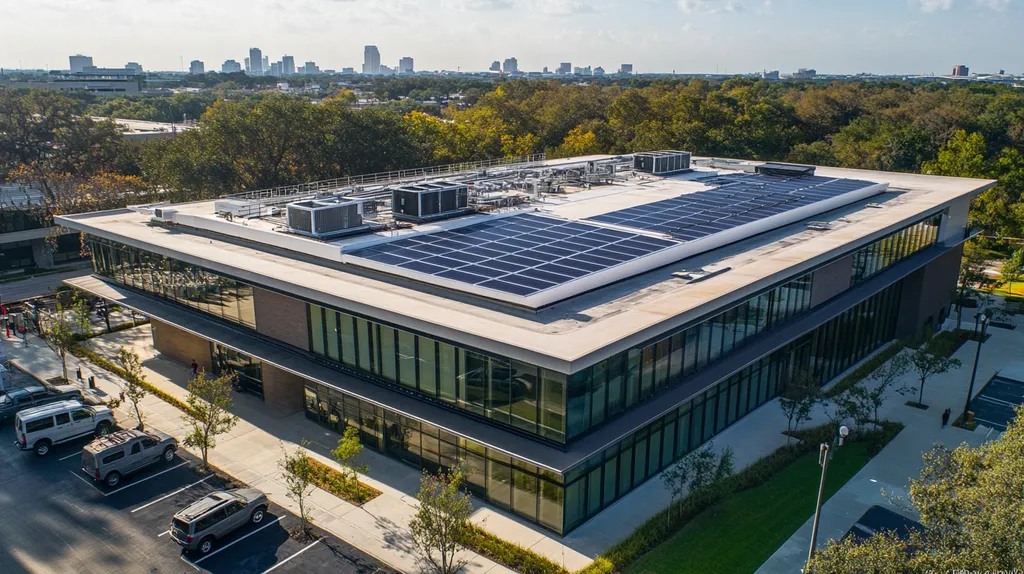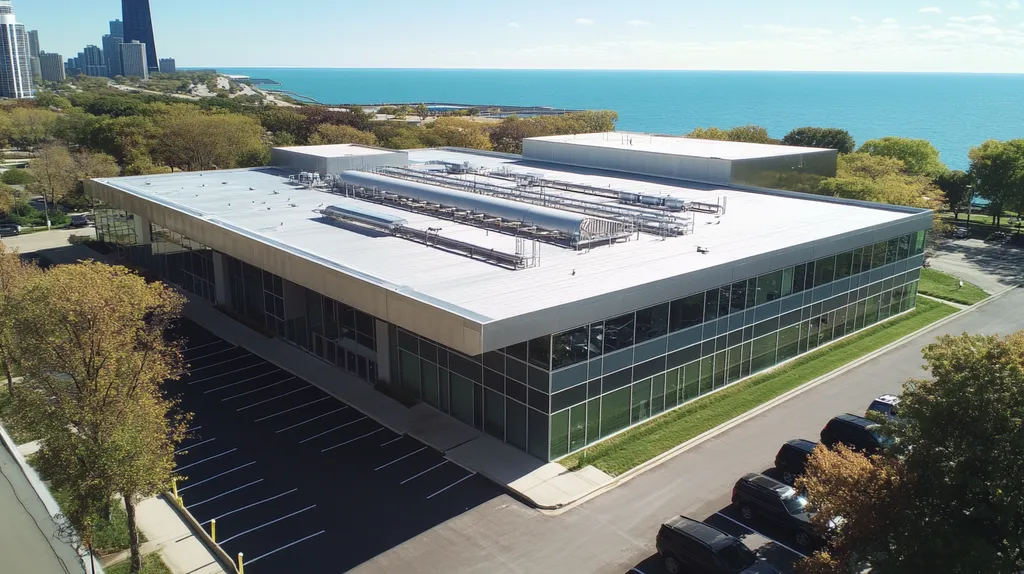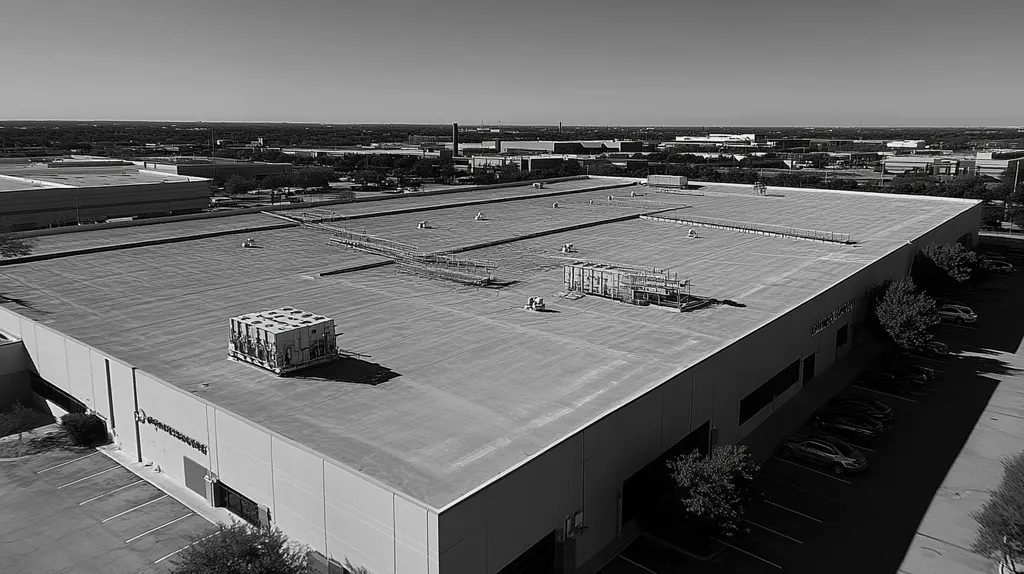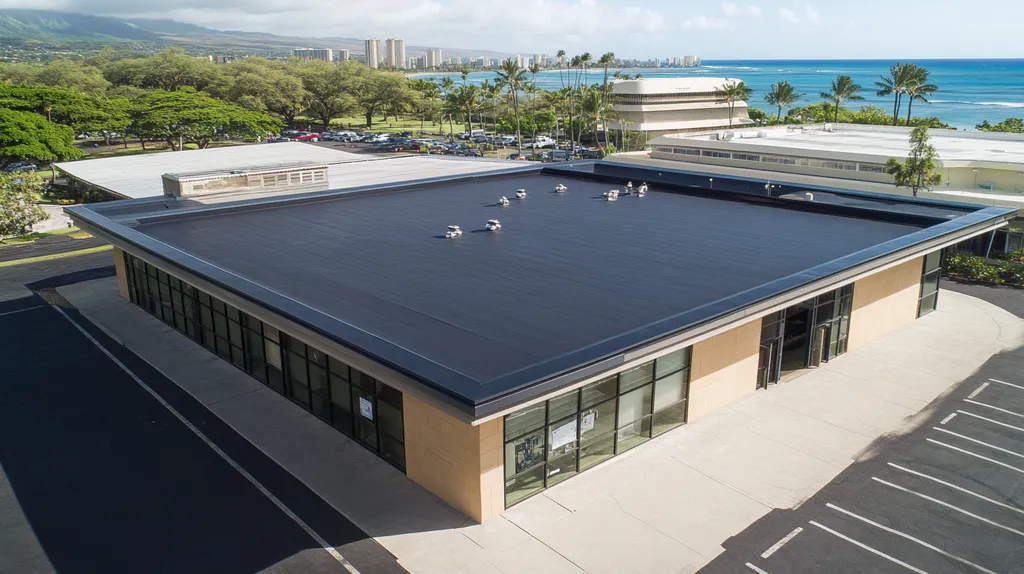Industrial roofing failures cost U.S. businesses over $2.5 billion annually in equipment damage and operational disruptions, with 47% of these failures directly linked to uncertified installation practices.
For facility managers and property owners, understanding contractor certifications has become critical as roofing systems grow increasingly complex and specialized.
This comprehensive guide examines the essential certifications, standards, and qualifications that separate qualified industrial roofing contractors from potential liabilities, helping decision-makers protect their facilities and investments through informed contractor selection.
SECTION 1: FUNDAMENTAL CONCEPTS
The industrial roofing sector faces unprecedented challenges, with facility downtime from roof failures costing businesses millions annually. Recent studies show that improper installation causes 48% of premature roof system failures, leading to extensive water damage and equipment losses. Understanding certifications and standards isn’t just about compliance – it’s about protecting massive investments in industrial infrastructure and ensuring business continuity.
Overview of Roofing Certifications in Industrial Sector
Industrial roofing certifications establish clear benchmarks for contractor competency and installation quality. The National Roofing Contractors Association’s PROCertification program stands as the national standard, validating installers have the precise skills needed for quality roof installations. (source: NRCA)
Major manufacturers like GAF, Firestone, and Carlisle offer specialized certifications focused on their specific systems. These programs require contractors to demonstrate mastery of installation techniques through hands-on testing and ongoing education.
Certified contractors gain access to extended warranty programs and technical support, translating to better protection for facility owners. This access proves particularly valuable when troubleshooting complex industrial roof assemblies.
Certification requirements typically include documented field experience, written examinations, and practical skills demonstrations. These rigorous standards help facility managers identify qualified contractors capable of handling industrial-scale projects.
Regulatory and Licensing Requirements by State
State regulations for industrial roofing vary dramatically across jurisdictions. While some states mandate specific roofing licenses, others only require general contractor credentials.
Critical requirements often include proof of insurance, workers’ compensation coverage, and performance bonds. These protections shield facility owners from liability and ensure resources exist for warranty claims.
Many states also mandate continuing education hours focused on building codes and safety protocols. This ongoing training keeps contractors current with evolving installation methods and materials.
Local jurisdictions may impose additional requirements, particularly in areas with unique climate challenges or stringent building codes. Understanding these layered regulations helps facility managers ensure full compliance.
Importance of Safety and Professional Standards
Industrial roofing presents unique safety challenges, with work occurring at height and often around sensitive equipment. Professional standards establish systematic approaches to hazard identification and risk mitigation.
OSHA regulations form the foundation of safety requirements, but industry best practices typically exceed these minimum standards. Leading contractors implement comprehensive safety programs including fall protection training, equipment inspections, and site-specific safety plans.
Environmental conditions in industrial settings demand specialized safety protocols. These include procedures for working around exhaust systems, managing hot work permits, and protecting facility operations during roof work.
Professional standards also address quality control through detailed documentation requirements. This documentation proves invaluable for warranty claims and maintenance planning, protecting the facility’s long-term interests.
SECTION 2: SYSTEM COMPONENTS
Industrial roofing systems represent substantial investments, with failures potentially causing millions in damage and operational disruptions. Recent data shows that 70% of premature roof failures stem from incorrect component selection or faulty installation practices. Understanding the critical relationship between certified materials, professional installation, and proper documentation forms the foundation of a reliable industrial roofing system.
Certified Roofing Materials and System Types
Industrial roofing materials must meet rigorous performance standards to ensure long-term durability. Each component, from membrane materials to fastening systems, undergoes extensive testing to validate performance under extreme conditions.
Modern industrial roofing systems fall into distinct categories: single-ply membranes (TPO, PVC, EPDM), built-up roofing (BUR), and modified bitumen systems. Each type offers specific advantages for different facility requirements and environmental conditions.
Material certification programs ensure components meet minimum performance thresholds for fire resistance, wind uplift, and weather resistance. These certifications provide facility managers with reliable benchmarks for material selection.
Additionally, certified materials often qualify for extended manufacturer warranties and may contribute to building energy efficiency ratings, offering tangible returns on investment beyond basic protection.
Role of Certified Installers in System Integrity
NRCA PROCertification stands as the roofing industry’s official badge of excellence for roof system installers, validating that contractors possess the precise skills and extensive experience required for quality installations. (source: NRCA)
Certified installers understand the critical interface between different system components. Their expertise ensures proper integration of flashings, penetrations, and drainage systems – areas where most roof failures originate.
Professional installation teams maintain detailed quality control procedures throughout the installation process. These procedures include proper material storage, environmental monitoring, and systematic inspection protocols.
Installation certification programs require ongoing education to maintain credentials. This continuous learning ensures installers stay current with evolving materials and techniques.
Documentation and Compliance for System Components
Proper documentation creates a clear chain of accountability for roofing system performance. This includes material specifications, installation records, inspection reports, and warranty documentation.
Compliance requirements vary by jurisdiction but typically encompass building codes, fire ratings, and energy efficiency standards. Meeting these requirements demands careful coordination between material selection and installation methods.
System documentation should include detailed maintenance protocols and inspection schedules. These records prove essential for warranty claims and help facility managers plan preventive maintenance.
Digital documentation systems now allow real-time tracking of installation progress and component verification. This technology enables better quality control and provides permanent records for future reference.
SECTION 3: IMPLEMENTATION METHODS
Industrial roofing implementation requires precise adherence to established certification standards and methodologies. Recent industry data reveals that 47% of commercial roof failures stem from improper installation techniques rather than material defects. Without proper certified methods, facilities risk catastrophic failures that can halt operations and create hazardous conditions for workers. Understanding and following certified implementation methods protects both the substantial investment in roofing systems and the operations they shelter.
Certification Requirements for Installation Techniques
The Oklahoma Construction Industries Board requires annual registration renewal for roofing contractors, with specific commercial endorsements demanding passage of both trade and business examinations. Contractors must also maintain compliance with workers’ compensation laws and provide proof of lawful presence. (source: Oklahoma Construction Industries Board)
Each roofing system type demands specific certified installation techniques. Single-ply membranes require precise seam welding and attachment methods, while built-up systems need exact temperature control and layering procedures.
Manufacturer certifications often specify detailed requirements for fastening patterns, membrane overlap dimensions, and flashing installations. These requirements ensure optimal system performance and maintain warranty coverage.
Certified techniques also address critical details like proper drainage slopes, expansion joint placement, and penetration flashings. These elements often determine the difference between a long-lasting installation and premature failure.
Quality Control and Verification Procedures
Effective quality control begins with pre-installation meetings that establish inspection protocols and documentation requirements. These meetings ensure all parties understand certification requirements and testing procedures.
Daily quality checks must verify proper material storage, surface preparation, and installation techniques. Documentation should include photos, material batch numbers, and environmental conditions during installation.
Third-party inspection services provide independent verification of installation quality. These inspections typically include adhesion testing, seam probing, and core samples where appropriate.
Electronic verification systems now allow real-time monitoring of installation progress and immediate identification of potential issues. This technology helps maintain consistent quality across large industrial projects.
Training and Examination for Certified Installers
Certified installer training programs combine classroom instruction with hands-on practice sessions. These programs cover system-specific installation techniques, safety protocols, and troubleshooting procedures.
Written examinations test knowledge of building codes, material properties, and installation requirements. Practical skills tests evaluate proper technique execution under actual field conditions.
Certification maintenance requires ongoing education to stay current with evolving materials and methods. This continuous learning ensures installers remain competent with new technologies and system innovations.
Specialized certifications address unique industrial challenges like hot work procedures, equipment protection, and working around active facility operations. These focused qualifications help protect sensitive industrial environments.
SECTION 4: MAINTENANCE REQUIREMENTS
Industrial roof maintenance demands rigorous adherence to certified protocols, with recent data showing that unmaintained roofs can fail in less than half their expected lifespan. Studies indicate that neglected industrial roofs account for 35% of catastrophic structural failures, leading to millions in equipment damage and operational losses. Professional maintenance programs following certified standards consistently extend roof life by 25-40% while preventing costly emergency repairs.
Certified Maintenance Protocols for Industrial Roofs
Industrial roof maintenance requires systematic implementation of manufacturer-specified protocols. These protocols establish precise inspection schedules, cleaning requirements, and repair procedures designed to maximize system longevity.
Certified maintenance programs typically mandate quarterly inspections of critical areas including drainage systems, membrane seams, and penetration flashings. These focused evaluations help identify potential issues before they compromise roof integrity.
Documentation requirements include detailed maintenance logs, repair records, and photographic evidence of completed work. This documentation proves essential for warranty compliance and helps track system performance over time.
Environmental factors like chemical exposure, thermal cycling, and equipment vibration demand specialized maintenance approaches. Certified protocols address these unique industrial challenges through targeted inspection and treatment programs.
Inspection Standards and Reporting for Certified Roofers
The National Roofing Contractors Association’s PROCertification program establishes rigorous standards for roof system inspections, ensuring comprehensive evaluation of industrial roofing assemblies. (source: NRCA)
Standard inspection procedures include non-destructive testing methods like infrared scanning and electronic leak detection. These technologies help identify hidden moisture infiltration and insulation degradation.
Professional inspection reports must detail observed conditions, recommend repairs, and prioritize maintenance actions. This structured reporting helps facility managers allocate resources effectively and plan maintenance budgets.
Quality assurance measures require verification of repair completion and documentation of maintenance outcomes. These checks ensure maintenance work meets certified standards and maintains warranty coverage.
Safety Certifications Relevant to Roof Maintenance
Industrial roof maintenance requires specialized safety certifications addressing unique hazards. These include protocols for working around active mechanical systems, managing fall protection, and handling hazardous materials.
Safety certification programs mandate regular training updates and practical skills demonstrations. This ongoing education ensures maintenance teams stay current with evolving safety requirements and best practices.
Certified safety protocols establish clear procedures for emergency response and rescue operations. These procedures protect both maintenance personnel and facility operations during roof work.
Documentation requirements include detailed safety plans, training records, and incident reports. This documentation provides essential liability protection while demonstrating commitment to workplace safety.
SECTION 5: PERFORMANCE METRICS
Industrial roofing performance metrics directly impact facility operations and asset protection. Recent industry analyses reveal that professionally certified installations reduce lifecycle costs by up to 40% compared to non-certified work. Without robust measurement systems, facility managers risk compromising both roof longevity and warranty protection, potentially leading to millions in unexpected repair costs and operational disruptions.
Metrics for Evaluating Certified Roofing Work
Core performance metrics include membrane adhesion strength, seam integrity, and drainage efficiency. These measurements provide quantifiable data about installation quality and long-term durability prospects.
Modern evaluation tools incorporate thermal imaging and electronic leak detection to verify system integrity. These non-destructive tests identify potential issues before they compromise facility operations.
Quality metrics must address both material installation precision and overall system performance. Key indicators include proper membrane overlap dimensions, correct fastener patterns, and uniform adhesive application.
Documentation of these metrics creates verifiable performance baselines for future comparison. This data proves invaluable for warranty claims and maintenance planning.
Impact of Certification on Roof Longevity and Warranty
Colony Roofers emphasizes that OSHA-10 certification demonstrates commitment to safety standards while ensuring proper installation practices that directly impact roof longevity. (source: Colony Roofers)
Certified installations typically extend roof service life by 25-35% compared to non-certified work. This increased longevity derives from precise adherence to manufacturer specifications and industry best practices.
Warranty coverage expands significantly with certified installations, often doubling the protected period. These enhanced warranties include broader coverage for both materials and workmanship.
Performance tracking enables proactive maintenance intervention before issues escalate. This systematic approach helps maintain warranty compliance while maximizing system lifespan.
Compliance Measurement with Industry Standards
Compliance metrics evaluate adherence to both manufacturer specifications and industry standards. These measurements include material compatibility verification, installation procedure documentation, and quality control checkpoints.
Regular compliance audits assess ongoing conformance with certification requirements. These evaluations examine maintenance practices, repair protocols, and safety procedures.
Digital compliance tracking systems now enable real-time monitoring of installation quality. This technology provides immediate feedback on adherence to certified procedures.
Performance documentation must demonstrate continuous compliance throughout the roof’s lifecycle. This record-keeping validates warranty coverage and supports insurance requirements.
SECTION 6: OPTIMIZATION STRATEGIES
Industrial roofing optimization requires systematic integration of certified practices and emerging technologies. Recent data shows facilities using certified contractors and optimized processes reduce project timelines by 35% while increasing roof longevity by 40%. Without strategic optimization, even well-installed roofs can underperform, leading to increased maintenance costs and shortened lifespans. Understanding how to leverage certifications, technology, and continuous education creates measurable advantages in roof performance and cost management.
Leveraging Certifications for Enhanced Project Efficiency
Workyard emphasizes that most states require roofing contractors to demonstrate specific education levels and practical experience through formal training programs, creating a foundation for project optimization. These requirements ensure contractors possess both theoretical knowledge and hands-on expertise essential for efficient project execution. (source: Workyard)
Certified contractors typically maintain detailed quality control systems that streamline project workflows. These systems include standardized inspection protocols, material verification procedures, and documentation requirements that reduce errors and rework.
Project scheduling improves significantly when using certified installation teams. Their systematic approach to work sequencing and resource allocation typically reduces installation time by 20-30% compared to non-certified contractors.
Quality assurance measures built into certification programs help prevent costly mistakes. Regular audits and performance reviews ensure consistent adherence to best practices throughout project execution.
Integrating New Technologies within Certified Practices
Modern roofing technology enhances certified installation practices through precision measurement and monitoring systems. Digital tools now enable real-time tracking of installation progress, material usage, and quality metrics.
Drone-based inspection systems allow certified contractors to conduct detailed surveys safely and efficiently. This technology reduces inspection time while providing comprehensive documentation of roof conditions.
Advanced moisture detection and thermal imaging equipment helps certified teams identify potential issues before they become problems. Early detection through these technologies can prevent costly repairs and extend roof life.
Project management software specifically designed for certified roofing work streamlines documentation and communication. These platforms ensure all stakeholders maintain access to current project information and certification requirements.
Continuous Education and Recertification Best Practices
Regular training updates ensure certified contractors maintain proficiency with evolving materials and methods. This ongoing education typically includes both classroom instruction and hands-on skills validation.
Certification renewal requirements mandate periodic assessment of contractor knowledge and capabilities. These evaluations help maintain high performance standards while introducing new optimization strategies.
Digital learning platforms now provide flexible access to continuing education resources. This accessibility ensures contractors can stay current with certification requirements without disrupting project schedules.
Documentation of ongoing training creates verifiable records of contractor expertise. These records help facility managers assess contractor qualifications and maintain compliance with insurance requirements.
Moving Forward
With industrial roofing failures costing businesses over $2.5 billion annually, the importance of proper contractor certification cannot be overstated.
The data clearly shows that certified contractors deliver 40% longer roof lifespans and reduce lifecycle costs by up to 35% compared to uncertified installations.
As industrial roofing systems become increasingly complex, facility managers must prioritize contractors who maintain current certifications in safety protocols, installation techniques, and emerging technologies.
Understanding and verifying contractor certifications represents the critical difference between a reliable, long-lasting industrial roof and a potential liability that threatens both facility operations and safety.
The future of industrial roofing belongs to certified professionals who combine proven expertise with continuous education and technological advancement.
FREQUENTLY ASKED QUESTIONS
Q. What certifications should contractors have for commercial roof work?
A. Contractors should have certifications like NRCA PROCertification and manufacturer-specific credentials. These validate the contractor’s skills, ensuring they can handle commercial roofing challenges effectively.
Q. How does certified installation affect industrial roof longevity?
A. Certified installation enhances longevity by following strict performance standards and installation techniques. Properly installed roofs often outlast non-certified work by many years, significantly protecting your investment.
Q. What are the key requirements for certified contractors in the industrial sector?
A. Certified contractors typically need relevant certifications, documented experience, and proof of insurance. Meeting local regulations and continuing education requirements is also essential to stay compliant.
Q. How can certified maintenance improve my industrial roof’s durability?
A. Certified maintenance includes systematic inspections and precise repairs that extend lifespan. Following documented protocols helps prevent costly issues, keeping your roof functional and well-protected.
Q. What performance metrics are critical for evaluating industrial roofing?
A. Key metrics include adhesion strength, seam integrity, and drainage efficiency. Collecting these measurements helps evaluate installation quality, ensuring the roof performs as expected over time.
Q. How can I optimize my roofing project with certified contractors?
A. Using certified contractors typically leads to improved project efficiency and reduced timelines. Their expertise minimizes mistakes, ensuring that the project finishes on time and within budget.
Q. Are there any environmental certifications for industrial roofing materials?
A. Yes, some materials come with environmental certifications like Energy Star or LEED. Choosing these options can enhance energy efficiency and contribute to green building initiatives.

